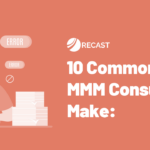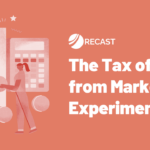The popularity of Marketing Mix Modeling (sometimes known as Media Mix Modeling, or simply MMM) has increased rapidly over the last few years as marketers – reliant on digital-tracking methods like multi-touch attribution – grapple with the implications of a reduced ability to track people across the internet due to regulations like GDPR and Apple’s App Tracking Transparency (ATT) policy.
Unfortunately, the old way of doing MMM that was developed 30+ years ago does not work for the pace of modern marketing. At Recast, we’ve developed a platform for modern marketing mix modeling that addresses many of the limitations of more legacy approaches. We believe modern MMM has a few key tenets:
- Modern MMM must be verifiable: Modern MMM shouldn’t be a black box, but rather a glass box that empowers marketers to verify that model results are accurate.
- Speed matters: modern MMM can generate initial insights in weeks, not months and can be refreshed on a near-real-time basis.
- Actionability is more important than interesting insights: Modern MMM focuses on helping marketers actually improve their performance, instead of just yielding interesting, backwards-looking insights or trying to explain away channel under-performance.
- Marketing is dynamic and change is unavoidable: Modern MMM doesn’t assume that channel performance is static over long periods of time, and instead, is adaptive to changing conditions.
All of these features make modern MMM much more useful for modern marketers than the legacy approaches that are slow, expensive, and make unrealistic assumptions about how marketing works in the real world.
In the remainder of this blog post, we’ll review the history of marketing mix modeling, discuss why customer level attribution based on click-tracking is insufficient, review the challenges with marketing mix modeling in the context of “programmatic” channels, and finally, we’ll discuss how Recast addresses these problems.
A brief history of MMM
The problem to solve
Imagine that you’re running the marketing department for a CPG brand in the 1980’s — your products are distributed through third-party retailers like Sears, grocery store chains, or a growing big-box retail chain called “Walmart”. Your primary advertising channels are television, radio, direct mail, and print advertising in newspapers. Critically, outside of the use of coupons (which have their obvious downsides and limitations), there is no good way to tell which people saw your advertisements and then went on to make a purchase.
“Half the money I spend on advertising is wasted; the trouble is I don’t know which half.” — John Wanamaker, retail pioneer
Enter the econometricians
In the late 80s and early 90s, econometricians began developing techniques to estimate the impact of these different advertising channels on sales. By using sophisticated regression techniques, they were able to link how changes in spend in the “media mix” – say, one week where spend in television increased and spend in radio decreased – to changes in the brand’s total sales. While some of the math under the hood can get tricky, the concept is straightforward: the models take advantage of “natural experiments” in the levels of media spend in order to understand how the different channels impact downstream sales.
This type of modeling became a critical tool in the marketing departments of large consumer-facing brands, and a number of companies and consulting firms stepped up to further develop this technology and provide the models as a service to brands. To this day, most large brands (especially those that are primarily distributed through brick-and-mortar stores) either do this type of modeling in-house or contract with an outside vendor in order to drive their planning and budgeting process.
Online advertising and attribution
With the rise of the internet and, especially, direct-to-consumer internet brands, the story changed. Starting in the 2010’s, brands like Warby Parker and Casper began selling directly to customers online and grew primarily with online advertising.
Critically, when advertising in channels like Facebook and Google search, advertisers can know exactly which customers saw their ads and whether they converted or not. So rather than having to use a complicated statistical model to estimate the impact of their advertising spend, they can see the “conversion rate” and ROI right at the top of the dashboard of any digital advertising platform.
Problem solved, right?
Unfortunately, digital advertising tracking turned out not to be the panacea that some had hoped. While we don’t have space for a deep-dive into the nitty-gritty details, we’ll cover most of the generally-accepted flaws with click-tracking-based attribution methods.
Last-click attribution over-credits bottom-of-funnel channels
Most companies that do click-tracking based attribution use what’s called “last-click” attribution. That is, when doing their ROI calculation, they attribute the sale to the last advertisement the customer clicked before converting. While in general this is a great way to get started measuring advertising efficacy, this methodology will over-credit channels that are closer to the bottom of the advertising funnel (like paid search) and will under-credit more awareness-building top-of-funnel channels (like video advertising on YouTube, linear TV and other offline channels).
How to integrate offline and online channels?
Most big brands today, even direct-to-consumer brands that only sell online, are advertising in a mix of online and offline channels: TV, Meta, Radio, SEM, Podcasts, Display Ads, Direct Mail, etc. This mix of channels exacerbates the problem with trying to use a pure click-based attribution model: you try to “track” customers coming from offline channels using coupon codes or surveys and then use a rule-of-thumb smudge to try and come up with an ROI estimate.
The more channels a company is operating in, the more these types of guesswork analyses can lead the marketing team astray and lead to millions of dollars wasted on channels that don’t actually drive incremental sales.
Correlation vs. Causation
This leads us to one of the subtler — but no less important — points. Even if a marketing team were to overcome all the measurement challenges across different types of channels that target different stages of the consumer journey, they would still be left with a thorny problem: digital-tracking attribution models don’t, even in principle, tell the marketer where they should allocate additional spend to drive incremental sales.
Why is this? Digital tracking attribution models don’t correct for something econometricians call endogeneity, which can be thought of as feedback loops. We think of increased spend on marketing as causing increased sales (and that’s the effect we want to isolate), but we have to remember that increased sales can also cause increased spend on marketing, and other factors can cause increases in both at the same time. For example, someone that was already going to buy your product might click on a Google ad because it’s the simplest way to get to your site, or a marketer might increase spend in anticipation of a seasonal bump that was going to increase your sales anyway.
Without correcting for endogeneity, attribution numbers are correlations, not causal effects, and should bear a large flashing warning of “past performance does not guarantee future results”.
The future is omni-channel
Most businesses have come to recognize that the future of retail is omni-channel. Brands like Casper, Warby Parker, and Harry’s have all moved into physical retail by opening their own brick-and-mortar locations or distributing through retailers like Walmart and Target, and brands like Nike have invested heavily in building a powerful e-commerce engine to complement their brick-and-mortar presence. In the omni-channel world, using a purely click-based attribution model begins to break down very quickly as it is not clear at all how to link impressions on Facebook to in-store conversions at Walmart.
This blend of omni-channel advertising and omni-channel purchase options has, justifiably, left modern marketers in a bind when it comes to deciding how to improve the overall performance of their marketing program.
Can Modern Marketing Mix Modeling Help?
Unfortunately, things aren’t as simple as they were in the olden days, and the statistical models developed in the past are no longer valid in a world where large amounts of money are spent on programmatic advertising where things can change very quickly.
How can modern MMM help?
- Modern MMM is verifiable: Modern MMM shouldn’t be a black box, but rather a glass box that empowers marketers to verify that model results are accurate.
- Speed matters: Modern MMM can generate initial insights in weeks, not months, and can be refreshed on a near-real-time basis.
- Actionability is more important than interesting insights: Modern MMM focuses on helping marketers actually improve their performance, instead of just yielding interesting, backwards-looking insights or trying to explain away channel under-performance.
- Marketing is dynamic and change is unavoidable: Modern MMM doesn’t assume that channel performance is static over long periods of time, and instead, is adaptive to changing conditions.
At Recast, our Modern MMM platform has been built from the ground up to work well for modern marketers who can’t afford to wait months to get results back from a legacy vendor and can no longer rely solely on digital tracking for measuring marketing performance.
If you’re interested in learning more send us an email at info@getrecast.com or request a demo.



